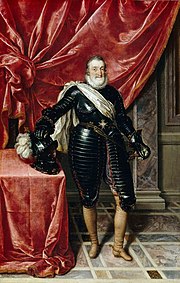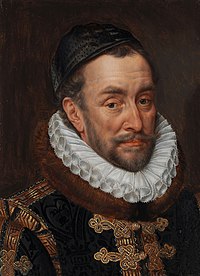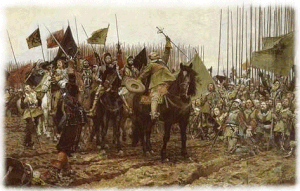Geschichte Europas/ Religionskriege
Introduction
[Bearbeiten]During the period of 1525 until 1648, Europe was plagued by wars of religion. It is important to recognize, however, that while religion was given as the reason for war; there were many other reasons as well. These included land, money and economics, political power, natural resources, and more.
These wars included the Peasants' War of 1525 in the Holy Roman Empire, the Schmalkaldic War of the 1540s through 1555, an ongoing fight between the Holy Roman Empire and the Turks, the Reconquista of the Spanish versus Muslims, the Hussite rebellion, and missionaries and conquistadors versus Native Americans.
Warfare
[Bearbeiten]Religious fighting and warfare spread with Protestantism. The radical new doctrine in Germany brought other simmering social tensions to a boil; peasant revolts flared in 1525, resulting in chaos and bloodshed across Austria, Switzerland and southern Germany. Wealthy landowners were the target of downtrodden rebels demanding social equality and sharing of wealth in common. Armies loyal to ruling princes suppressed the revolt, and the leaders were executed. Martin Luther, chief initiator of the Reformation, turned against the rebels and defended the authorities' moves to put them down.
Peace of Augsburg
[Bearbeiten]
The Peace of Augsburg in 1555 declared the Prince's religion to be the official religion of a region or country (cuius regio, eius religio). This resulted in the acceptance of toleration of Lutheranism in Germany by Catholics. When a new ruler of a different religion took power, large groups had to convert religions. Most people found this to be realistic, and the process did not end until 1648.
In northern Europe (north Germany, Netherlands, and France), the middle class tended to be Protestant, which corresponded with their work ethic and philosophy. Peasants readily converted religions in order to obtain jobs.
Treaty of Cateau-Cambrésis
[Bearbeiten]With the Treaty of Cateau-Cambrésis in 1559, Spain and France agreed to stop fighting with each other in order to unite against their common Protestant threat, particularly Calvinism, which was considered more of a threat than Lutheranism.
French War of Religion
[Bearbeiten]In France, religious civil war took place from 1558 to 1598 between royalty (the Catholic League) and nobility (the Protestant Huguenots). The three leading families in the nation competed for control of France. These families were the Valois family, which was currently in power and was Catholic, the Bourbon family, which consisted of Huguenots, and the Guise family, who was also Catholic. Ultimately, the Bourbon family won the war, but Henry Bourbon of Navarre was unable to be crowned because the city of Paris shut itself down. Henry put Paris under a year of siege that killed 50,000 to 70,000 citizens. However, the siege came to an end because Philip II of Spain sent troops, resulting in Henry Bourbon converting to Catholicism and stating that, "Paris is worth a mass." The civil war in France was ended by the Edict of Nantes in 1598, which declared Catholicism the official religion in France. The Edict did, however, allow freedom to Protestants.
Henry IV could be described as a politique, or one who cares more about his nation's peace and prosperity than he does the enforcement of religious toleration.
Spanish Conflict with the Dutch
[Bearbeiten]In 1566, on the Assumption of the Virgin day, a group of Calvinists in the Netherlands stormed Catholic churches, destroying statutes and relics in a town just outside of Antwerp. Dutch Calvinists resented the Catholic religion and their conflicts with the religion, as well as Spanish King Philip II's deep devoutness and close-mindedness toward other religions. The high nobility pleaded with him for more tolerance but some of them were put to death for their insolence. One of the underlying reasons was that Philip wanted to establish an absolute monarchy in the Netherlands and the religious issue gave him a way to put pressure on the parliament. William of Orange escaped to Germany from where he tried to incite a rebellion from 1568 onwards but with little success at first. In 1570 the coastal regions got hit by a Katrina-like event, the All Saints flood that left many regions devastated and the Spanish authorities showed little compassion. William of Orange, then encouraged Sea Beggars, or pirates, to invade the ports of the coast. In 1572 the small town of Brielle was taken by what were no more than outlaws, greeted enthusiastically by the population. The town declared itself for the prince of Orange and this example was followed by a number of other towns in the relatively inaccessible provinces of Holland and Zeeland.

Philip sent Spanish troops in response. They took Naarden and Haarlem and inflicted horrible suffering on the population. Other towns proved far harder to take and this caused Philip to run out of money. In what became known as the Spanish Fury, in November of 1576, Philip's unpaid mercenary armies attacked the city of Antwerp killing 7,000 in 11 days. Antwerp was by far the richest city at the time and the influential merchants got the parliament to convene and raise money to pay off the marauding mercenaries. By doing so the parliament basically took over control from the king in far Madrid and this was the last thing the king wanted. He sent more troops with an ultimatum to the parliament to surrender or else and appointed the Duke of Parma as the new governor of the Netherlands. In 1579, the southern ten provinces of the Netherlands, which were Catholic, signed the Union of Arras, expressing loyalty to Philip. During that same year, William of Orange united seven northern states in the Union of Utrecht, which formed the Dutch Republic that openly opposed Philip and Spain. In 1581, the Spanish army was sent to retake the United Provinces of the Netherlands, or the Dutch Republic, who had just declared their independence.
On July 10, 1584, William of Orange was assassinated, and after his death, the Duke of Parma made progress in his reconquest, capturing significant portions of the Dutch Republic. However, England, under the leadership of Elizabeth I, assisted the Dutch with troops and horses, and as a result Spain was never able to regain control of the north. Spain finally recognized Dutch independence in 1648.
Die Spanische Armada
[Bearbeiten]
Der katholische Philipp II. von Spanien wollte Elisabeth I. von England vom Thron stoßen, nachdem sie nach dem Sturz der "blutigen" Mary Tudor durch Krankheit an die Macht gekommen war. Philipp war in erster Linie über Elisabeths Vorgehen gegen die englischen Katholiken verärgert, aber auch über die Angriffe englischer Freibeuter auf spanische Schiffe, über Elisabeths Unterstützung für Spaniens Feinde wie die Niederlande und über die Hinrichtung von Maria, der Königin der Schotten, war er aufgebracht.
Philipp entwarf einen Plan zur Invasion Englands. Die vier Komponenten dieses Plans bestanden darin, eine große Armee unter der Führung des Herzogs von Parma in die Niederlande zu bringen und sie auf die Invasion Englands vorzubereiten. Darüber hinaus sollte der Herzog von Medina-Sardinien eine große Flotte mit zusätzlichen Männern vorbereiten und die Männer ausrüsten, um sich mit der Armee des Herzogs von Parma zu vereinen. Dann würde Spanien seine Flotte einsetzen, um die Kontrolle über den Ärmelkanal zu erlangen und die Invasionstruppen des Herzogs von Parma bei der Überquerung zu schützen. Schließlich würden die Truppen in England einmarschieren und Elisabeth zwingen, den Forderungen Spaniens zuzustimmen: den englischen Katholiken zu erlauben, den Gottesdienst so zu feiern, wie sie es wollten, die Unterstützung der protestantischen holländischen Rebellen in den spanischen Niederlanden einzustellen und Reparationen für die Kosten der Invasion sowie für die englischen Schäden an spanischen Schiffen zu zahlen. Philipp hatte jedoch nicht die Absicht, England zu erobern - er wollte lediglich, dass Elisabeth den Forderungen Spaniens nachgab. Allerdings hatte Papst Sixtus V. am 29. Juli 1587 die päpstliche Vollmacht erteilt, Elisabeth, die von Papst Pius V. zur Ketzerin erklärt worden war, zu stürzen und eine Person seiner Wahl auf den englischen Thron zu setzen.
Anfängliche Probleme des Plans
[Bearbeiten]Bei Philipps Plan gab es eine Reihe von Problemen. Zunächst wurde der Herzog von Medina-Sardinien zum Leiter der Operation ernannt. Er hatte keine Erfahrung mit der Seefahrt und war fatalistisch. Außerdem verweigerte der Herzog von Parma die Zusammenarbeit, da er den Oberbefehl haben wollte. Infolgedessen konnte er nicht genügend Schiffe zusammenstellen. Außerdem überfiel der Engländer Sir Francis Drake während der Vorbereitungen die Stadt Cádiz und versenkte 30 spanische Schiffe und verbrannte Fassdauben, was dazu führte, dass die Lebensmittel für die Armada verdorben waren. Schließlich bestand die Invasion aus 131 Schiffen, was die Kommunikation erschwerte.
Der Angriff
[Bearbeiten]Die Armada traf Ende Juli 1588 ein und wurde sofort von englischen Ausguckern entdeckt. Zu diesem Zeitpunkt benötigte der Herzog von Parma noch einige Tage, um die Truppen vorzubereiten. Am 20. Juli entwickelte der englische Admiral Howard den Plan, die spanische Flotte mit Feuerschiffen anzugreifen, d. h. mit Schiffen, die mit brennbaren Stoffen gefüllt waren. Diese Angriffe führten dazu, dass die spanische Flotte ihre Anker lichtete. Am 29. Juli kam es zur großen Konfrontation, der sogenannten Schlacht von Gravelines. Die Taktik der Spanier war veraltet: Sie segelten dicht heran, feuerten eine Salve auf die englischen Schiffe und enterten sie dann. Die englische Marine hatte jedoch eine neue Taktik entwickelt: Sie setzte kleinere, wendigere Schiffe mit beweglichen Kanonen mit größerer Reichweite ein. Diese neue Taktik war jedoch nicht ausschlaggebend, da den Schiffen in Formation nur wenig Schaden zugefügt wurde. Andererseits führte jeder Versuch, die Formation zu verlassen, zur sofortigen Zerstörung durch das gemeinsame Feuer der englischen Schiffe. Als es der englischen Flotte gelang, die spanische Formation mit Brennern zu zerstreuen, beschloss die Armada, sich zurückzuziehen. Dies und der so genannte "protestantische Wind", der die spanischen Schiffe durch den Ärmelkanal blies, führten zur spanischen Niederlage.
Am 28. Mai 1588 war die Armada mit 131 Schiffen und 30.000 Mann in See gestochen. 67 Schiffe und etwa 10.000 Mann kehrten zurück. Viele Schiffe sanken an der irischen Küste, etwa 5000 Männer verhungerten und andere wurden in Irland von den englischen Behörden hingerichtet.
Ergebnisse der Spanischen Armada
[Bearbeiten]Die spanische Flotte konnte sich zwar zahlenmäßig von dieser Niederlage erholen, aber die Moral war zerrüttet. Die Ereignisse markierten den Aufstieg der englischen Seemacht. Darüber hinaus führten sie zur Unabhängigkeit der Niederlande, da Spanien England nicht besiegen konnte. Die Ereignisse waren somit ein Schlag für die Gegenreformation und führten zu einem allgemeinen Rückgang der Auswirkungen der Gegenreformation.
The Decline of Spain
[Bearbeiten]It is a common misconception that the failure of the armada resulted in the decline of Spain.
After the failed invasion of England, Spain soon began to enter a period of decline. This occurred for a number of reasons. The Counter-Reformation had drained considerable Spanish resources. Moreover, many of the resources of the Spanish colonies had been exhausted. Additionally, only one-third of Spain's population actually worked - one-third of the population belonged to the clergy and another one-third belonged to lower nobility - and there was no middle class in Spain, and a small higher class. Finally, inbreeding caused inept leadership in the monarchy.
The Thirty Years' War
[Bearbeiten]
The Thirty Years' War was sparked by the Defenestration of Prague, at which Protestants threw Catholic ambassadors out of a window in the city of Prague.
The Thirty Years' War had started as a war along religious frontlines. In the end it was no more a war of religion. The Catholic French funded and traded the Protestant Dutch, Protestant Princes in the Holy Roman Empire, as well as other non-Catholic nations such as Sweden, Denmark, and Turkey, since all of these nations were fighting the Hapsburgs. France, led by Cardinal Richelieu, regent for Louis XIII, desired to reduce the power of Austria by funding Austria's enemies. The war was essentially a fight between the two powers to determine which would become the main power in Europe.
Although a high member of the Catholic Church, Richelieu can be described as a politique, as he put his nation's interests ahead of his religion. Indeed, Richelieu openly funded Protestant groups in his fight against Austria.
Precursors to the War
[Bearbeiten]The Schmalkaldic Wars and the Peace of Augsburg of the 1540s through 1555 created a number of issues for Charles V Hapsburg of Austria. The debate over what religion German states could adopt had not been resolved, as the Peace of Augsburg provided for the states' princes to adopt either Catholicism or Lutheranism, but not Calvinism. The issue of the German princes' power and sovereignty was also at bay, as the princes increasingly desired more power. Finally, the princes had been seizing Church land, angering Charles V.
Bohemian Phase (1618-1625)
[Bearbeiten]Protestant Bohemians rebelled for religious freedom and independence from Hapsburg rule. The Defenestration of Prague, in which rebels threw two of the Holy Roman Emperor's, Ferdinand II, Catholic officials from a castle window, initiated the war in 1618. After ruthless retaliation by Ferdinand, Bohemia was completely converted to Catholicism and defeated.
Danish Phase (1625-1630)
[Bearbeiten]King Christian of Denmark supported north German Protestants. Catholic general Albert Wallenstein was hired to defeat Protestant forces and restore Catholic land lost. As a result of Austrian victories, Ferdinand II issues the Edict of Restitution in 1629, ordering that no longer could Protestants seize and secularize Catholic land. In the Siege of Madgeburg, Wallenstein's mercenary force, out of control, massacred the entire town of Madgeburg, including both Protestants and Catholics. Again, Austria is victorious, and Denmark is relatively easily defeated.
Swedish Phase (1630-1635)
[Bearbeiten]Swedish King Gustavus Adolphus, devout Lutheran, came to Germany's aid. Austria ultimately defeated Sweden, and it looked like peace was likely. The Edict of Restitution was thus withdrawn.
French/International Phase (1635-1648)
[Bearbeiten]France benefited from the strengthened Hapsburg Empire. France joined the fray in 1647 by declaring war on Spain and forging an alliance with the Calvinist Dutch to assist them in their fight against Spain for independence. As a result of French support, and exhaustion on all sides after endless fighting, all were ready for peace.
Peace of Westphalia (1648)
[Bearbeiten]
The Treaty of Westphalia ended the last major religious war in Europe. The settlement would serve as a model for resolving conflict among warring European nations, as it represented the first time a diplomatic congress addressed and resolved a dispute. This was the first time that all parties were brought together at once rather than two or three at a time.
Beneficiaries of the Treaty of Westphalia
[Bearbeiten]- France, now the dominant power in Europe, surpassing Spain and Austria. France also got Alsace-Loraine and wins the Thirty Years' War, stopping German unity.
- Dutch and the House of Orange. Spain and the Holy Roman Empire finally recognized their independence, and for the next 60 years, were the leaders in trade, shipping, and a major economic powerhouse in Europe.
- Swiss. They earned independence from the Holy Roman Empire.
- Sweden. They now controlled the Baltic Sea and became the most powerful nation in the north.
- Prussia and the Hohenzollerns. This marked the start of Prussia's rise as a great military power.
- German princes. The princes now won sovereignty and could select Calvinism for their states.
- Protestants. The Peace of Westphalia marked the end of the Counter-Reformation and Calvinism was now tolerated.
Losers at Westphalia
[Bearbeiten]- Spain and the Spanish Hapsburgs. The Spanish lost colonies and territorial possessions, resulting in a loss in income.
- The Holy Roman Empire, Austria, and the Austrian Hapsburgs. 1648 marked the effective end of the Holy Roman emperor and thus the influence of the Holy Roman Empire, as the princes are now sovereign.
- Catholicism. The Peace of Westphalia marked the end of the enforced Counter-Reformation and thus the end of the church's supremacy and papal authority.
- German Unity. Germany was kept disunited and was divided into hundreds of individual, sovereign states governed by princes.
